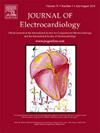Electrocardiogram abnormalities in left bundle branch block and out-of-hospital cardiac arrest
IF 1.2
4区 医学
Q3 CARDIAC & CARDIOVASCULAR SYSTEMS
引用次数: 0
Abstract
Background
Left bundle branch block (LBBB) can be a marker of cardiovascular risk. This study investigates how electrocardiogram (ECG) measurements can be utilized in risk stratification of LBBB patients.
Methods
Using registry data from the Copenhagen General Practitioners Laboratory, first-time LBBB ECGs were identified from 2001 to 2015. Different ECG parameters were extracted including P-wave duration, PR interval, QRS duration, QRS area, QTc, JTc intervals and heart rate. Data were stratified according to the median values of these parameters (below vs above). The outcome was out-of-hospital cardiac arrest (OHCA), and the crude 5-year risk of OHCA was calculated for each subgroup. Multivariable Cox proportional hazards regression was employed to assess associations of ECG parameters with OHCA.
Results
We identified 4644 patients with incident LBBB contributing to a combined 35,113 person-years follow-up (median age 75 [25th - 75th percentiles 66–83] years; male sex, 62 %). Over the study period, all-cause mortality was 50 % and 4 % reached the primary outcome. The crude 5-year risk of OHCA revealed significant associations for QRS duration >150 ms (p = 0.01) and JTc duration >317 ms (p = 0.03). Multivariable analysis showed a higher hazard ratio (HR) for OHCA associated with QRS duration >150 ms (HR 1.41 [95 % CI 1.06–1.88]), QTc duration >464 ms (HR 1.43 [95 % CI 1.08–1.90]), JTc duration >317 ms (HR 1.50 [95 % CI 1.13–2.00]) and heart rate > 72/min (HR 1.48 [95 % CI 1.12–1.97]).
Conclusion
This study provides insights into associations between specific ECG parameters and the risk of OHCA in patients with LBBB. This holds the potential for risk stratification and targeted intervention in this population, and individuals with LBBB and these specific ECG abnormalities might benefit from earlier referral to investigation by specialists.

左束支传导阻滞和院外心脏骤停的心电图异常
背景:左束支阻滞(LBBB)可作为心血管危险的标志。本研究探讨了心电图(ECG)测量如何用于LBBB患者的风险分层。方法使用哥本哈根全科医生实验室的注册数据,收集2001年至2015年首次LBBB心电图。提取心电图参数包括p波持续时间、PR间期、QRS持续时间、QRS面积、QTc、JTc间期和心率。根据这些参数的中位数(上与下)对数据进行分层。结果为院外心脏骤停(OHCA),并计算每个亚组的OHCA粗5年风险。采用多变量Cox比例风险回归评估心电图参数与OHCA的相关性。结果:我们确定了4644例LBBB患者,共进行了35,113人年的随访(中位年龄75岁[25 - 75个百分点66-83]岁;男性,62%)。在研究期间,全因死亡率为50%,4%达到主要结局。粗5年OHCA风险与QRS持续时间>;150 ms (p = 0.01)和JTc持续时间>;317 ms (p = 0.03)有显著相关性。多变量分析显示,OHCA的高危险比(HR)与QRS持续时间>;150 ms (HR 1.41 [95% CI 1.06-1.88])、QTc持续时间>;464 ms (HR 1.43 [95% CI 1.08-1.90])、JTc持续时间>;317 ms (HR 1.50 [95% CI 1.13-2.00])和心率>;72/min (HR 1.48 [95% CI 1.12-1.97])。结论本研究揭示了LBBB患者特定心电图参数与OHCA风险之间的关系。这为这一人群的风险分层和有针对性的干预提供了可能,LBBB和这些特定ECG异常的个体可能会从早期转诊到专家的调查中受益。
本文章由计算机程序翻译,如有差异,请以英文原文为准。
求助全文
约1分钟内获得全文
求助全文
来源期刊

Journal of electrocardiology
医学-心血管系统
CiteScore
2.70
自引率
7.70%
发文量
152
审稿时长
38 days
期刊介绍:
The Journal of Electrocardiology is devoted exclusively to clinical and experimental studies of the electrical activities of the heart. It seeks to contribute significantly to the accuracy of diagnosis and prognosis and the effective treatment, prevention, or delay of heart disease. Editorial contents include electrocardiography, vectorcardiography, arrhythmias, membrane action potential, cardiac pacing, monitoring defibrillation, instrumentation, drug effects, and computer applications.
 求助内容:
求助内容: 应助结果提醒方式:
应助结果提醒方式:


